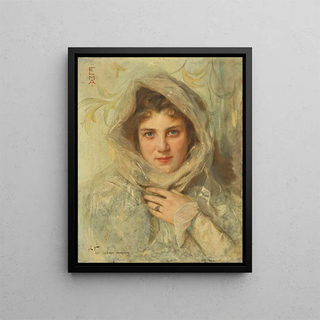Art print | Portrait of Wilhelmine Prétorius - Philip Alexius de László


View from behind

Frame (optional)
Portrait of Wilhelmine Prétorius - Philip Alexius de László – Captivating Introduction
The "Portrait of Wilhelmine Prétorius" by Philip Alexius de László is a work that continually amazes with its emotional depth and timeless elegance. This painting, which captures the essence of a woman who is both strong and delicate, transports us into a universe where art and psychology intersect. De László, master of the portrait, manages to immortalize his model's personality with such finesse that one could almost hear the whisper of her thoughts. This piece is much more than a simple representation; it is an open window into the human soul, a poignant testament to the beauty and complexity of human relationships.
Style and uniqueness of the work
Philip Alexius de László's style is distinguished by its ability to blend realism and impressionism. In the "Portrait of Wilhelmine Prétorius," the meticulous details of the face, clothing, and accessories are combined with light touches that breathe palpable life into the canvas. The color palette chosen by the artist, dominated by warm and soft tones, creates an intimate atmosphere where each nuance seems to tell a story. De László excels in the art of capturing emotions with such precision that he manages to make the moment eternal. Wilhelmine's gaze, both thoughtful and engaging, invites us to share a moment of complicity, to discover the thoughts that inhabit her. This portrait, in sum, is a true masterpiece that transcends time and space, offering a unique visual and emotional experience.
The artist and his influence
Philip Alexius de László, born in 1869, is a renowned portrait artist whose talent has captivated the most prominent figures of his era. Trained at the Academy of Fine Arts in Budapest, he developed a personal style that combines tradition and modernity. De László had the honor of painting influential personalities, from aristocrats to artists, and his influence on the world of portraiture is undeniable. He redefined the codes of portraiture by incorporating elements of psychology and storytelling, allowing

Matte finish

View from behind

Frame (optional)
Portrait of Wilhelmine Prétorius - Philip Alexius de László – Captivating Introduction
The "Portrait of Wilhelmine Prétorius" by Philip Alexius de László is a work that continually amazes with its emotional depth and timeless elegance. This painting, which captures the essence of a woman who is both strong and delicate, transports us into a universe where art and psychology intersect. De László, master of the portrait, manages to immortalize his model's personality with such finesse that one could almost hear the whisper of her thoughts. This piece is much more than a simple representation; it is an open window into the human soul, a poignant testament to the beauty and complexity of human relationships.
Style and uniqueness of the work
Philip Alexius de László's style is distinguished by its ability to blend realism and impressionism. In the "Portrait of Wilhelmine Prétorius," the meticulous details of the face, clothing, and accessories are combined with light touches that breathe palpable life into the canvas. The color palette chosen by the artist, dominated by warm and soft tones, creates an intimate atmosphere where each nuance seems to tell a story. De László excels in the art of capturing emotions with such precision that he manages to make the moment eternal. Wilhelmine's gaze, both thoughtful and engaging, invites us to share a moment of complicity, to discover the thoughts that inhabit her. This portrait, in sum, is a true masterpiece that transcends time and space, offering a unique visual and emotional experience.
The artist and his influence
Philip Alexius de László, born in 1869, is a renowned portrait artist whose talent has captivated the most prominent figures of his era. Trained at the Academy of Fine Arts in Budapest, he developed a personal style that combines tradition and modernity. De László had the honor of painting influential personalities, from aristocrats to artists, and his influence on the world of portraiture is undeniable. He redefined the codes of portraiture by incorporating elements of psychology and storytelling, allowing






